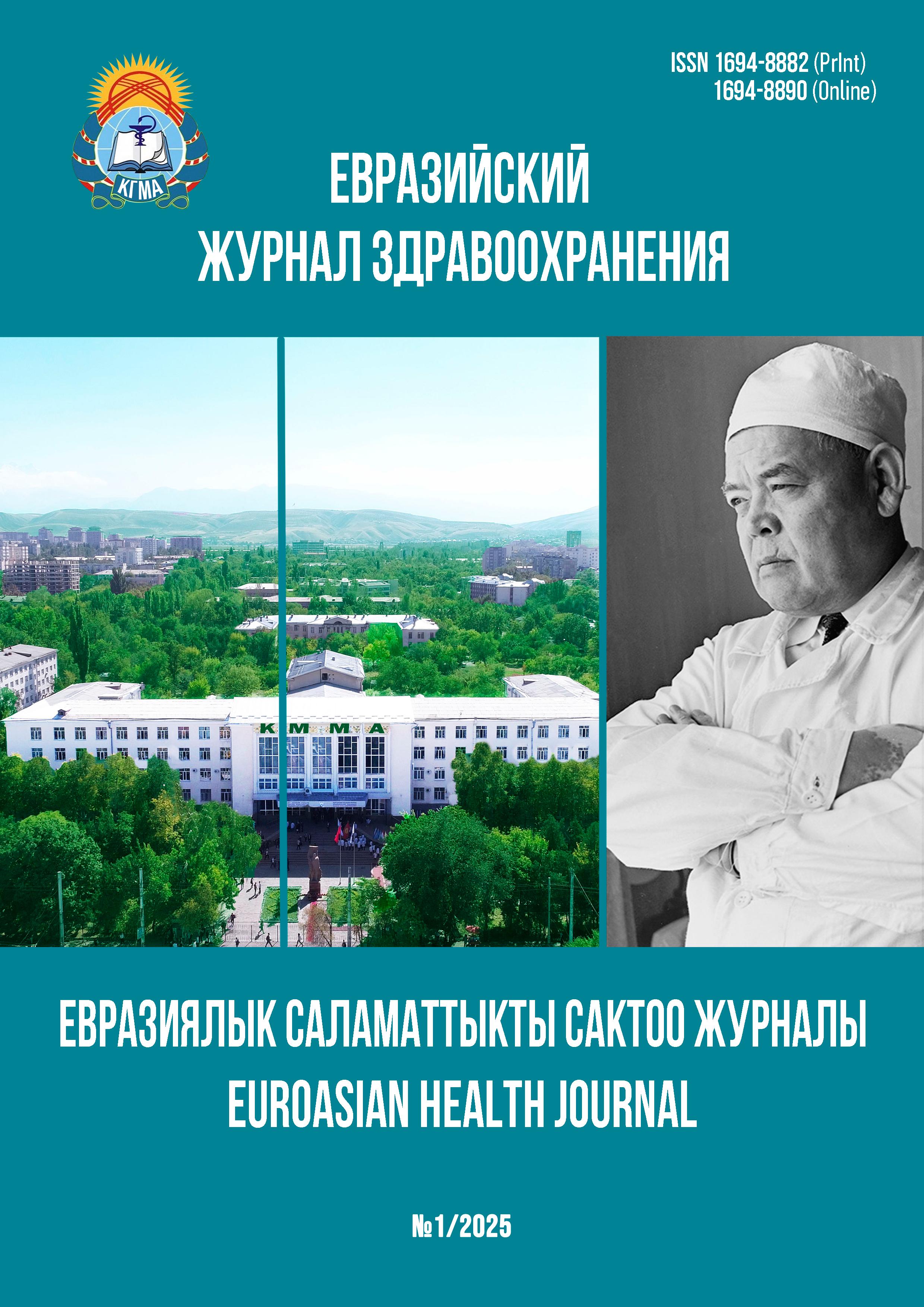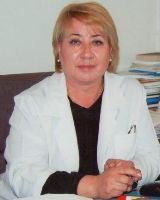FEATURES OF THE DISTRIBUTION OF HIGHLY SENSITIVE TROPONIN I CONCENTRATION AMONG RESIDENTS OF THE CHUI REGION OF THE KYRGYZ REPUBLIC, TAKING INTO ACCOUNT GENDER AND AGE
DOI:
https://doi.org/10.54890/1694-8882-2025-1-36Abstract
The aim of the study: was to investigate the distribution of the concentration of highly sensitive troponin I (hsTnI) in a representative sample of residents of the Chui region of the Kyrgyz Republic, taking into account gender and age.
Material and methods. The material was a representative sample of the population aged 18-65 years in the Kyrgyz Republic (n = 1276, including 529 men and 747 women). An analysis of the distribution of hsTnI levels in the population was carried out taking into account gender and age. The level of hsTnI in blood serum samples was measured by immunochemiluminescent assay with microparticles, using Architect Stat High Sensitive Troponin I reagents (Abbott, USA) on an automated analyzer Architect i2000SR (Abbott, USA). The level of statistical significance was taken to be 0.05.
Results. The median hsTnI concentration in the sample was 1.2 pg/ml, the interquartile range was (0.6; 2.0) pg/ml. The 99th percentile was 19.7 pg/ml. hsTnI levels were significantly higher in men -1.5 (0.8; 2.3) pg/ml, than in women - 1.0 (0.4; 1.8) pg/ml, (p = 0.009). The relationship between hsTnI concentration and age was characteristic of both men (r = 0.13; p = 0.002) and women (r = 0.16; p<0.001). Despite the lower initial values of hsTnI concentration, the rate of its increase with age was higher in women. A detailed comparative analysis of the dynamics of hsTnI concentration in different age groups in men and women was carried out.
Conclusion. The revealed gender differences in the distribution of hsTnI concentration and its age dynamics must be taken into account when determining the threshold levels of this biomarker.
Keywords:
cardiovascular diseases, risk factors - troponin I, age and gender differencesReferences
1. World Health Organization. Cardiovascular Diseases (CVDs). 2021. [Accessed November 12, 2022]. Available from: https://www.who.int/en/newsroom/fact-sheets/detail/cardiovasculardiseases-(cvds).
2. Republican Medical Information Center. Public health and activities of healthcare organizations of the Kyrgyz Republic [cited 2022 Dec 9]. Available from: http://cez.med.kghttp://cez.med.kg/wp-content/uploads.zip
3. Khot UN, Khot MB, Bajzer CT, Sapp SK, Ohman EM, Brener SJ, et al. Prevalence of conventional risk factors in patients with coronary heart disease. JAMA. 2003;290(7):898-904. https://doi.org/10.1001/jama.290.7.898
4. Long B, Long DA, Tannenbaum L, Koyfman A. An emergency medicine approach to troponin elevation due to causes other than occlusion myocardial infarction. Am J Emerg Med. 2020;38(5):998–1006. https://doi.org/10.1016/j.ajem. 2019.12.007
5. Masri W, Le Guillou E, Hamdi E, Ghazal K, Lebigot E, Cosson C, et al. Troponin elevation in other conditions than acute coronary syndromes. Ann Biol Clin (Paris). 2017;75(4):411–419. https://doi.org/10.1684/abc.2017.1262
6. Blankenberg S, Salomaa V, Makarova N, Ojeda F, Wild P, Lackner KJ, et al. Troponin I and cardiovascular risk prediction in the general population: The BiomarCaRE consortium. Eur Heart J. 2016;37(30):2428-2437. https://doi.org/10.1093/ eurheartj/ehw172
7. Klinkenberg LJJ, Wildi K, van der Linden N, Kouw IW, Niens M, Twerenbold R, et al. Diurnal rhythm of cardiac troponin: consequences for the diagnosis of acute myocardial infarction. Clin Chem. 2016;62(12):1602-1611. https://doi.org/10.1373/clinchem.2016.257485
8. Shah A, Griffiths M, Lee KK, McAllister DA, Hunter AL, Ferry AV, et al. High sensitivity cardiac troponin and the underdiagnosis of myocardial infarction in women. BMJ. 2015;350:g7873. https://doi.org/10.1136/bmj.g7873
9. Шальнова С.А., Драпкина О.М., Концевая А.В., Яровая Е.Б., Куценко В.А., Метельская В.А. и др. Пилотный проект по изучению тропонина I в представительной выборке одного из регионов-участников исследования ЭССЕ-РФ: распределение в популяции и ассоциации с факторами риска. Кардиоваскулярная терапия и профилактика. 2021;20(4):2940. https://doi.org/10.15829/1728-8800-2021-2940
10. Шальнова С.А., Драпкина О. М., Концевая А.В., Яровая Е.Б., Куценко В.А., Метельская В.А. и др. Пилотный проект по изучению ассоциации тропонина I с сердечно-сосудистыми осложнениями в популяции российского региона. Кардиоваскулярная терапия и профилактика. 2021;20(5):2980. https://doi.org/ 10.15829/1728-8800-2021-2980
11. Полупанов А.Г., Концевая А.В., Мамасаидов Ж.А., Халматов А.Н., Алтымышева А.Т., Джумагулова А.С. Распространенность метаболического синдрома и его компонентов среди жителей Кыргызской Республики трудоспособного возраста. Казанский медицинский журнал 2016;97(4):618-624. https://doi.org/ 10.14341 /omet12704
12. Полупанов А.Г., Халматов М.Н., Махмудов М.Т. Мамасаидов Ж.А, Ческидова Н.Б., Романова Т.А., и др. Распространенность дислипидемий среди жителей Кыргызской Республики трудоспособного возраста (по данным международного исследования “ИнтерЭпид”). Вестник Кыргызско-Российского Славянского университета. 2014;14(5):128-132.
13. Концевая А.В., Мырзаматова А.О., Драпкина О.М. Биомаркеры в прогнозировании сердечно-сосудистого риска: новые возможности тропонина I. Кардиоваскулярная терапия и профилактика. 2020;19(3):2584. https://doi.org/10.15829/1728-8800-2020-2584
14. Richardson AJ, Leckie T, Watkins ER, Fitzpatrick D, Galloway R, Grimaldi R, et al. Post marathon cardiac troponin T is associated with relative exercise intensity. J Sci Med Sport. 2018;21(9):880-884. https://doi.org/10.1016/j.jsams.2018.02.005
15. Lazzarino AI, Hamer M, Gaze D, Collinson P, Steptoe A. The association between cortisol response to mental stress and high-sensitivity cardiac troponin T plasma concentration in healthy adults. J Am Coll Cardiol. 2013;62(18):1694-1701. https://doi.org/10.1016/j.jacc.2013.05.070
16. Zaninotto M, Padoan A, Mion MM, Marinova M, Plebani M. Short-term biological variation and diurnal rhythm of cardiac troponin I (Access hs-TnI) in healthy subjects. Clin Chim Acta. 2020;504:163-167. https://doi.org/10.1016/ j.cca.2020.02.004
17. Apple FS, Ler R, Murakami MM. Determination of 19 cardiac troponin I and T assay 99th percentile values from a common presumably healthy population. Clin Chem. 2012;58(11):1574-1581. https://doi.org/10.1373/clinchem.2012.192716
18. Jia X, Sun W, Hoogeveen RC, Nambi V, Matsushita K, Folsom AR, et al. High-Sensitivity Troponin I and Incident Coronary Events, Stroke, Heart Failure Hospitalization, and Mortality in the ARIC Study. Circulation. 2019;139(23):2642-2653. https://doi.org/10.1161/CIRCULATIONAHA.118.038772
19. Чаулин А.М., Абашина О.Е., Дупляков Д.В. Высокочувствительные сердечные тропонины (hs-Tn): методы определения и основные аналитические характеристики. Кардиоваскулярная терапия и профилактика. 2021;20(2):2590. https://doi.org/10.15829/1728-8800-2021-2590
20. Romiti GF, Cangemi R, Toriello F, Ruscio E, Sciomer S, Moscucci F, et al. Sex-Specific Cut-Offs for High-Sensitivity Cardiac Troponin: Is Less More? Cardiovasc Ther. 2019;2019(1):9546931. https://doi.org/10.1155/2019/9546931
21. Базира К.К., Мусакеев А.О., Киндербаева Н.К., Кундашев У.К., Мамажакып У.Ч., Эсенгельдиева О.Э., Маматов С.М. Анализ антитромботической терапии у пожилых людей в клинической практике центров семейной медицины Кыргызской Республики. Тромбоз, гемостаз и реология. 2021;84(1):40-47. https://doi.org/10.25555/THR.2021.1.0960
22. Shah ASV, Sandoval Y, Noaman A, Sexter A, Vaswani A, Smith SW, et al. Patient selection for high sensitivity cardiac troponin testing and diagnosis of myocardial infarction: prospective cohort study [published correction appears in BMJ. 2018;360:k495. https://doi.org/10.1136/bmj.k495.]. BMJ. 2017;359:j4788. Published 2017 Nov 7. https://doi.org/10.1136/ bmj.j4788







